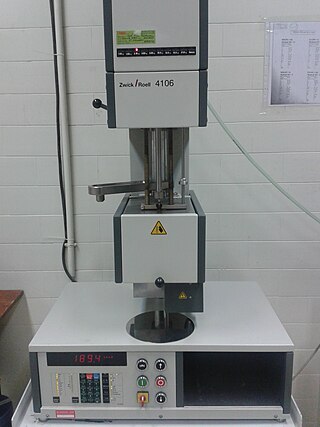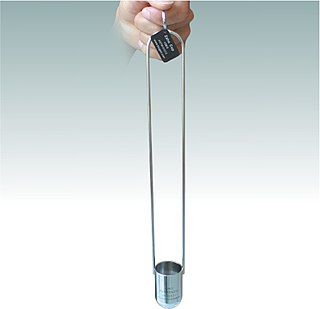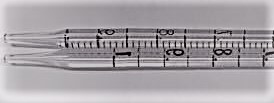Standard temperature and pressure (STP) or standard conditions for temperature and pressure are various standard sets of conditions for experimental measurements used to allow comparisons to be made between different sets of data. The most used standards are those of the International Union of Pure and Applied Chemistry (IUPAC) and the National Institute of Standards and Technology (NIST), although these are not universally accepted. Other organizations have established a variety of other definitions.

Relative density, also called specific gravity, is a dimensionless quantity defined as the ratio of the density of a substance to the density of a given reference material. Specific gravity for solids and liquids is nearly always measured with respect to water at its densest ; for gases, the reference is air at room temperature. The term "relative density" is preferred in SI, whereas the term "specific gravity" is gradually being abandoned.
A viscometer is an instrument used to measure the viscosity of a fluid. For liquids with viscosities which vary with flow conditions, an instrument called a rheometer is used. Thus, a rheometer can be considered as a special type of viscometer. Viscometers can measure only constant viscosity, that is, viscosity that does not change with flow conditions.
Flow measurement is the quantification of bulk fluid movement. Flow can be measured using devices called flowmeters in various ways. The common types of flowmeters with industrial applications are listed below:

The flash point of a material is the "lowest liquid temperature at which, under certain standardized conditions, a liquid gives off vapours in a quantity such as to be capable of forming an ignitable vapour/air mixture".

The International Standard Atmosphere (ISA) is a static atmospheric model of how the pressure, temperature, density, and viscosity of the Earth's atmosphere change over a wide range of altitudes or elevations. It has been established to provide a common reference for temperature and pressure and consists of tables of values at various altitudes, plus some formulas by which those values were derived. The International Organization for Standardization (ISO) publishes the ISA as an international standard, ISO 2533:1975. Other standards organizations, such as the International Civil Aviation Organization (ICAO) and the United States Government, publish extensions or subsets of the same atmospheric model under their own standards-making authority.
The dropping point of a lubricating grease is an indication of the heat resistance of the grease and is the temperature at which it passes from a semi-solid to a liquid state under specific test conditions. It is dependent on the type of thickener used and the cohesiveness of the oil and thickener of a grease. The dropping point indicates the upper temperature limit at which a grease retains its structure though is not necessarily the maximum temperature at which a grease can be used.
The American Petroleum Institute gravity, or API gravity, is a measure of how heavy or light a petroleum liquid is compared to water: if its API gravity is greater than 10, it is lighter and floats on water; if less than 10, it is heavier and sinks.

A rheometer is a laboratory device used to measure the way in which a viscous fluid flows in response to applied forces. It is used for those fluids which cannot be defined by a single value of viscosity and therefore require more parameters to be set and measured than is the case for a viscometer. It measures the rheology of the fluid.

The Melt Flow Index (MFI) is a measure of the ease of flow of the melt of a thermoplastic polymer. It is defined as the mass of polymer, in grams, flowing in ten minutes through a capillary of a specific diameter and length by a pressure applied via prescribed alternative gravimetric weights for alternative prescribed temperatures. Polymer processors usually correlate the value of MFI with the polymer grade that they have to choose for different processes, and most often this value is not accompanied by the units, because it is taken for granted to be g/10min. Similarly, the test conditions of MFI measurement are normally expressed in kilograms rather than any other units. The method is described in the similar standards ASTM D1238 and ISO 1133.
Moisture vapor transmission rate (MVTR), also water vapor transmission rate (WVTR), is a measure of the passage of water vapor through a substance. It is a measure of the permeability for vapor barriers.

A Zahn cup is a viscosity measurement device used in the paint industry. It is commonly a stainless steel cup with a tiny hole drilled in the centre of the bottom of the cup. There is also a long handle attached to the sides. There are five cup specifications, labelled Zahn cup #x, where x is the number from one through five. Large number cup sizes are used when viscosity is high, while low number cup sizes are used when viscosity is low. They are manufactured in accordance to ASTM D 4212, ASTM D1084 and ASTM D816
The salt spray test is a standardized and popular corrosion test method, used to check corrosion resistance of materials and surface coatings. Usually, the materials to be tested are metallic and finished with a surface coating which is intended to provide a degree of corrosion protection to the underlying metal.
An Ubbelohde type viscometer or suspended-level viscometer is a measuring instrument which uses a capillary based method of measuring viscosity. It is recommended for higher viscosity cellulosic polymer solutions. The advantage of this instrument is that the values obtained are independent of the total volume. The device was developed by the German chemist Leo Ubbelohde (1877-1964).
The air permeability specific surface of a powder material is a single-parameter measurement of the fineness of the powder. The specific surface is derived from the resistance to flow of air through a porous bed of the powder. The SI units are m2·kg−1 or m2·m−3.

The Marsh funnel is a simple device for measuring viscosity by observing the time it takes a known volume of liquid to flow from a cone through a short tube. It is standardized for use by mud engineers to check the quality of drilling mud. Other cones with different geometries and orifice arrangements are called flow cones, but have the same operating principle.

The viscosity of a fluid is a measure of its resistance to deformation at a given rate. For liquids, it corresponds to the informal concept of "thickness": for example, syrup has a higher viscosity than water. Viscosity is defined scientifically as a force multiplied by a time divided by an area. Thus its SI units are newton-seconds per square meter, or pascal-seconds.

Oxidation induction time or OIT is a standardized test performed in a DSC which measures the level of thermal stabilization of the material tested. The time between melting and the onset of decomposition in isothermal conditions is measured. The atmosphere is nitrogen up to melting and then oxygen. The typical temperature is 190-220 °C.

A graduated pipette is a pipette with its volume, in increments, marked along the tube. It is used to accurately measure and transfer a volume of liquid from one container to another. It is made from plastic or glass tubes and has a tapered tip. Along the body of the tube are graduation markings indicating volume from the tip to that point. A small pipette allows for more precise measurement of fluids; a larger pipette can be used to measure volumes when the accuracy of the measurement is less critical. Accordingly, pipettes vary in volume, with most measuring between 0 and 25.0 millilitres.
Flow cups are designed to accurately measure the viscosity of paints, inks, varnishes and similar products. The process of flow through an orifice can often be used as a relative measurement and classification of viscosity. This measured kinematic viscosity is generally expressed in seconds of flow time which can be converted into centistokes (cSt) using a viscosity calculator.










